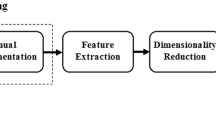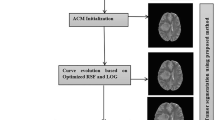Abstract
Segmenting tumor automatically in human brain Magnetic Resonance (MR) images is challenging because of uneven, irregular and unstructured size and shape of the tumor. This paper proposes an automated two stage brain tumor segmentation method. In the first stage, coarse estimation of the brain tumor is carried out using convex hull approach. The coarse estimate thus obtained is employed as the initialization for the active contour model applied in the second stage thereby eliminating the need of human intervention. Multiscale Harris energy is estimated at different levels to identify high-energy regions and thereafter constructing convex hull over the selected key-points in order to detect the abnormality in the input MR images. The proposed method is applied to 2-d axial images of fluid attenuated inversion recovery (FLAIR) and post-contrast T1-weighted (T1c) MRI images from the brain tumor segmentation benchmark challenge 2015 (BRATS2015) dataset. Different sub-compartments of the tumor such as enhanced tumor, edema, and necrosis are segmented and in addition combined in the form of tumor core, complete tumor, and enhanced tumor labels. The proposed method is evaluated in terms of Dice Similarity Coefficient (DSC), Sensitivity and Positive Predictive Value (PPV). Average DSC score of 81% for brain tumor core, 92% for complete brain tumor, and 83% for enhanced brain tumor are achieved which is better than several state-of-the-art methods.









Similar content being viewed by others
Explore related subjects
Discover the latest articles and news from researchers in related subjects, suggested using machine learning.References
Agn M, Puonti O, Law I, af Rosenschöld P, van Leemput K (2015) Brain tumor segmentation by a generative model with a prior on tumor shape. In: Proceeding of the multimodal brain tumor image segmentation challenge, pp 1–4
Avola D, Cinque L (2008) Encephalic nmr image analysis by textural interpretation. In: Proceedings of the 2008 ACM symposium on applied computing. ACM, pp 1338–1342
Avola D, Cinque L, Di Girolamo M (2011) A novel t-cad framework to support medical image analysis and reconstruction. In: International conference on image analysis and processing. Springer, pp 414–423
Avola D, Cinque L, Placidi G (2013) Customized first and second order statistics based operators to support advanced texture analysis of mri images. Computational and mathematical methods in medicine 2013
Bahadure NB, Ray AK, Thethi HP (2018) Comparative approach of mri-based brain tumor segmentation and classification using genetic algorithm. J Digit Imaging 31(4):477–489
Banday SA, Mir AH (2017) Statistical textural feature and deformable model based brain tumor segmentation and volume estimation. Multimed Tools Appl 76 (3):3809–3828
Bauer S, Nolte LP, Reyes M (2011) Fully automatic segmentation of brain tumor images using support vector machine classification in combination with hierarchical conditional random field regularization. In: International conference on medical image computing and computer-assisted intervention. Springer, pp 354–361
Bauer S, Wiest R, Nolte LP, Reyes M (2013) A survey of mri-based medical image analysis for brain tumor studies. Phys Med Biol 58(13):R97
Bharath H, Colleman S, Sima D, Van Huffel S (2017) Tumor segmentation from multimodal mri using random forest with superpixel and tensor based feature extraction. In: International MICCAI brainlesion workshop. Springer, pp 463–473
Chan TF, Vese LA (2001) Active contours without edges. IEEE Trans Image Process 10(2):266–277. https://doi.org/10.1109/83.902291
Corso JJ, Sharon E, Dube S, El-Saden S, Sinha U, Yuille A (2008) Efficient multilevel brain tumor segmentation with integrated bayesian model classification. IEEE Trans Med Imaging 27(5):629–640
Cui S, Mao L, Jiang J, Liu C, Xiong S (2018) Automatic semantic segmentation of brain gliomas from mri images using a deep cascaded neural network, vol 2018
Dice LR (1945) Measures of the amount of ecologic association between species. Ecol 26(3):297–302
Drevelegas A, Nasel C (2010) Imaging of brain tumors with histological correlations. Springer Science & Business Media, New York
Dupont C, Betrouni N, Reyns N, Vermandel M (2016) On image segmentation methods applied to glioblastoma: state of art and new trends. IRBM 37(3):131–143
Fletcher-Heath LM, Hall LO, Goldgof DB, Murtagh FR (2001) Automatic segmentation of non-enhancing brain tumors in magnetic resonance images. Artif Intell Med 21(1-3):43–63
Gong YJ, Zhou Y (2018) Differential evolutionary superpixel segmentation. IEEE Trans Image Process 27(3):1390–1404
Gonzalez RC, Woods RE (2002) Digital image processing, Third Edition. Publishing house of electronics industry
Gupta N, Bhatele P, Khanna P (2019) Glioma detection on brain mris using texture and morphological features with ensemble learning. Biomed Signal Process Control 47:115–125
Hamamci A, Kucuk N, Karaman K, Engin K, Unal G (2012) Tumor-cut: segmentation of brain tumors on contrast enhanced mr images for radiosurgery applications. IEEE Trans Med Imaging 31(3):790–804
Harris C, Stephens M (1988) A combined corner and edge detector. In: Alvey vision conference, vol 15. Citeseer, pp 147–151
Hasan AM, Meziane F, Aspin R, Jalab HA (2016) Segmentation of brain tumors in mri images using three-dimensional active contour without edge. Symmetry 8(11):132
Havaei M, Davy A, Warde-Farley D, Biard A, Courville A, Bengio Y, Pal C, Jodoin PM, Larochelle H (2017) Brain tumor segmentation with deep neural networks. Med Image Anal 35:18–31
Hndu: Over 2,500 indian kids suffer from brain tumour every year www.thehindu.com/sci-tech/health/Over-2500-Indian-kids-suffer-from-brain-tumour-every-year/article14418512.ece (2018). Last Accessed: June 2019
Hsieh TM, Liu YM, Liao CC, Xiao F, Chiang IJ, Wong JM (2011) Automatic segmentation of meningioma from non-contrasted brain mri integrating fuzzy clustering and region growing. BMC Med Inf Decis Making 11(1):54
Kamnitsas K, Ledig C, Newcombe VF, Simpson JP, Kane AD, Menon DK, Rueckert D, Glocker B (2017) Efficient multi-scale 3d cnn with fully connected crf for accurate brain lesion segmentation. Med Image Anal 36:61–78
Kass M, Witkin A, Terzopoulos D (1988) Snakes: active contour models. Int J Comput Vis 1(4):321–331
Kim J, Feng DD, Cai TW, Eberl S (2002) Automatic 3d temporal kinetics segmentation of dynamic emission tomography image using adaptive region growing cluster analysis. In: Nuclear science symposium conference record, 2002 IEEE, vol 3. IEEE, pp 1580–1583
Kistler M, Bonaretti S, Pfahrer M, Niklaus R, Büchler P (2013) The virtual skeleton database: an open access repository for biomedical research and collaboration. J Med Internet Res 15(11):e245
Lun T, Hsu W (2016) Brain tumor segmentation using deep convolutional neural network. In: Proceedings of BRATS-MICCAI
Menze BH, Jakab A, Bauer S, Kalpathy-Cramer J, Farahani K, Kirby J, Burren Y, Porz N, Slotboom J, Wiest R et al (2015) The multimodal brain tumor image segmentation benchmark (brats). IEEE Trans Med Imaging 34 (10):1993–2024
Menze BH, Van Leemput K, Lashkari D, Weber MA, Ayache N, Golland P (2010) A generative model for brain tumor segmentation in multi-modal images. In: International conference on medical image computing and computer-assisted intervention. Springer, pp 151–159
Mohan G, Subashini MM (2018) Mri based medical image analysis: survey on brain tumor grade classification. Biomed Signal Process Control 39:139–161
Mumford D, Shah J (1989) Optimal approximations by piecewise smooth functions and associated variational problems. Comm Pure Appl Math 42(5):577–685
Nabizadeh N, Kubat M (2017) Automatic tumor segmentation in single-spectral mri using a texture-based and contour-based algorithm. Expert Syst Appl 77:1–10
Osher S, Sethian JA (1988) Fronts propagating with curvature-dependent speed: algorithms based on hamilton-jacobi formulations. J Comput Phys 79(1):12–49
Pereira S, Pinto A, Alves V, Silva C (2016) Brain tumor segmentation using convolutional neural networks in mri images. IEEE Trans Med Imaging 35(5):1240–1251
Pereira S, Pinto A, Alves V, Silva CA (2015) Deep convolutional neural networks for the segmentation of gliomas in multi-sequence mri. In: International workshop on brainlesion: glioma, multiple sclerosis, stroke and traumatic brain injuries. Springer, pp 131–143
Prastawa M, Bullitt E, Ho S, Gerig G (2004) A brain tumor segmentation framework based on outlier detection. Med Image Anal 8(3):275–283
Pratondo A, Chui CK, Ong SH (2017) Integrating machine learning with region-based active contour models in medical image segmentation. J Vis Commun Image Represent 43:1–9
Ren X, Malik J (2003) Learning a classification model for segmentation. In: Null. IEEE, p 10
Sachdeva J, Kumar V, Gupta I, Khandelwal N, Ahuja CK (2012) A novel content-based active contour model for brain tumor segmentation. Magn Reson Imaging 30(5):694–715
Sachdeva J, Kumar V, Gupta I, et al. (2013) Segmentation, feature extraction, and multiclass brain tumor classification. J Digit Imaging 26(6):1141–1150
Shivhare SN, Kumar N (2019) Brain tumor detection using manifold ranking in flair mri. In: International conference on emerging trends in information technology. Springer in press
Shivhare SN, Sharma S, Singh N (2019) An efficient brain tumor detection and segmentation in mri using parameter-free clustering. In: Machine intelligence and signal analysis. Springer, pp 485–495
Soltaninejad M, Yang G, Lambrou T, Allinson N, Jones TL, Barrick TR, Howe FA, Ye X (2018) Supervised learning based multimodal mri brain tumour segmentation using texture features from supervoxels. Comput Methods Prog Biomed 157:69–84
Song B, Chou CR, Chen X, Huang A, Liu MC (2016) Anatomy-guided brain tumor segmentation and classification. In: International workshop on brainlesion: glioma, multiple sclerosis, stroke and traumatic brain injuries. Springer, pp 162–170
Tong J, Zhao Y, Zhang P, Chen L, Jiang L (2019) Mri brain tumor segmentation based on texture features and kernel sparse coding. Biomed Signal Process Control 47:387–392
Wang K, Ma C (2016) A robust statistics driven volume-scalable active contour for segmenting anatomical structures in volumetric medical images with complex conditions. Biomed Eng Online 15(1):39
Zhao X, Wu Y, Song G, Li Z, Fan Y, Zhang Y (2016) Brain tumor segmentation using a fully convolutional neural network with conditional random fields. In: International workshop on brainlesion: glioma, multiple sclerosis, stroke and traumatic brain injuries. Springer, pp 75–87
Zhao X, Wu Y, Song G, Li Z, Zhang Y, Fan Y (2018) A deep learning model integrating fcnns and crfs for brain tumor segmentation. Med Image Anal 43:98–111
Author information
Authors and Affiliations
Corresponding author
Additional information
Publisher’s note
Springer Nature remains neutral with regard to jurisdictional claims in published maps and institutional affiliations.
Rights and permissions
About this article
Cite this article
Shivhare, S.N., Kumar, N. & Singh, N. A hybrid of active contour model and convex hull for automated brain tumor segmentation in multimodal MRI. Multimed Tools Appl 78, 34207–34229 (2019). https://doi.org/10.1007/s11042-019-08048-4
Received:
Revised:
Accepted:
Published:
Issue Date:
DOI: https://doi.org/10.1007/s11042-019-08048-4
Keywords
Profiles
- Navjot Singh View author profile




